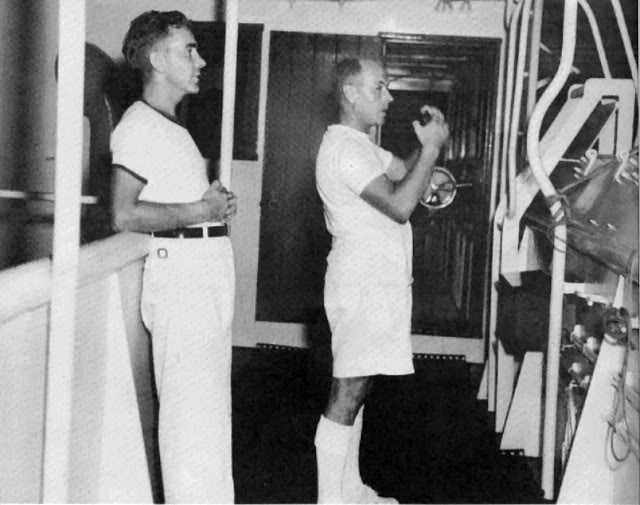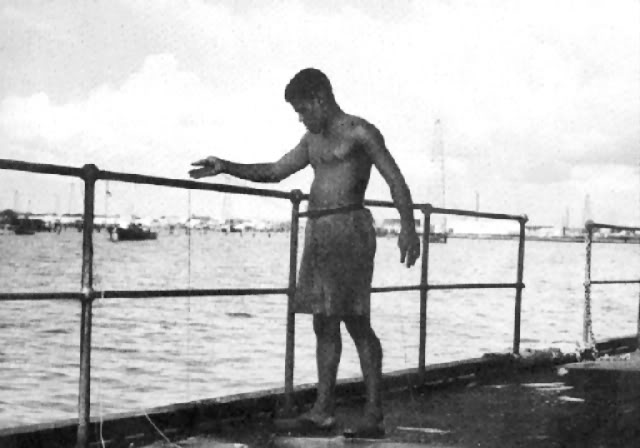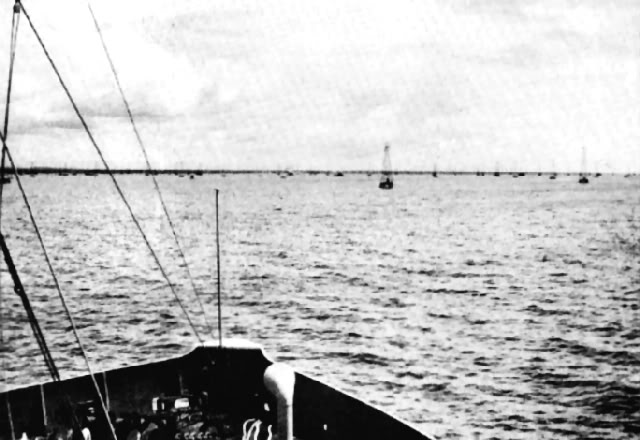Auke Visser's Other Esso Related Tankers Site | home
Lago's Sea side.
This article gives another brief account of the ships and their activities-now only a memory.
From : "this is LAGO", A PUBLICATION BY LAGO OIL & TRANSPORT CO. LTD. EXPLAINING THE COMPANY.
Some refineries receive their crude oil and ship their products entirely by pipeline or railroad tank car. To Lago, however, the sea is all-
important as a highway for raw materials and finished products. Its refinery is separated from producing areas by 150 miles, and form
markets by 150 to 12,000 miles, all over water.
One of Lago's marine links with the rest of the world is the Lake Fleet, with nearly 60 ships and 1,400 men shuttling ceaselessly
between Aruba and Maracaibo to keep the stills charged with crude oil. Most of these ships were specially built for the service, with
wide beams, shallow draft, and twin rudders and propellers for quick maneuvering. They are designed to cross safely over the tricky
shifting sand bars that separate Lake Maraciabo from the Caribbean Sea. The earliest lake tankers that are still operating are now
twenty-three years old. One of the oldest has made over 2,600 round trips to the lake since 1925, In recent years a number of ships
have been pressed into service on a charter basis, including one of the first ocean tankers that served as a depot ship at Oranjestad
in 1925, and even, for a while, a small ship that formerly carried molasses, and another that carried wine between North Africa and
France.

First officer Alan Dawes, on the left, and Captain Sydney Mills are both on the bridge as the "Temblador" nears Aruba
for a night docking.
Growth of the fleet is dramatically shown by the change in capacity; the original three "lakers" had a combined cubic capacity of
24.000 barrels Today's fleet can carry over one and a half million barrels. Navigation into Lake Maracaibo has always been governed
by the passage over the lake's outer and inner bars. For many years a channel was navigable by loaded tankers at high tide only; it
was maintained only by natural causes and by the "scouring" action of ships propellers continually passing back and forth. By 1937,
however, this channel was deteriorating, and it became necessary to restrict traffic. Lago joined a co-operative effort in assisting
nature to keep the passage clear, the to make the channel deeper for passage of larger ships. The lake tanker
Invercaibo" was converted to a dredge, and has spent the last ten years sucking sand into the hoppers that replaced its cargo tanks,
and dumping it in distant point in the sea. Since 1938 the channel has been deepened from nine feet to seventeen feet at low water,
and intermediate size ocean tankers cross the but safely at high tide at drafts of over twenty feet The ships normally make the round
trip, from departure time at Aruba until they are unloaded here and ready to start on the next trip. in approximately three days. Haulage
varies somewhat from month to month. In 1947 the monthly average was 378 ship arrivals from Maracaibo, bringing in 11,982.346 bar-
rels per month, A peak was reached in March, 1948, when 131 shiploads totaled 13,702.138 barrels.

Marcelino Breed, during a trick at the wheel, keeps a close eye on the compass.
The ships that tie up at Lago's docks to lake away its finished oil represent almost every seagoing flag: Dutch, Scandinavian, Ameri-
can, British. Panamanian, and many others, including even the Swiss, Beyond the huge oil cargoes loaded in routine business, fuel
oil has been pumped into submarines, cruisers, and other warships, round-the-world yachts, and whaling ships away to the Antarctic
hunting grounds. Ashore, marine operations occupy 775 men.

Linton Bonn whiles away a spare hour fishing in the Lake of Maracaibowhile his ship loads.
They man the Fleet and provision it, repair it and keep it shipshape, and operate it on a schedule that best meets the needs of the
refinery in Aruba and the producing fields in Venezuela. They act as agents of the owners of all deep sea tankers loading at San
Nicolas, often provisioning and repairing them.

The lake tankers thread their way through fields of derricks to pick up cargoes in Lake Maracaibo.
As tanker runs go, the 150-mile trip from Aruba to Maracaibo is like a step across the street. The bigger ships on the ocean routes
may travel several thousand miles with a single cargo; their routes crisscross the seven seas. The "lakers," on the other hand, shut-
tle endlessly on the same short route. Since 1925 the oldest of them have traveled nearly a million miles over the same stretch of
water. It might well be called "the longest short haul in the world".